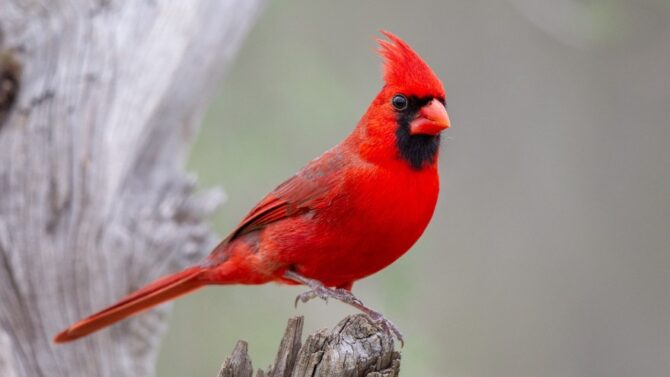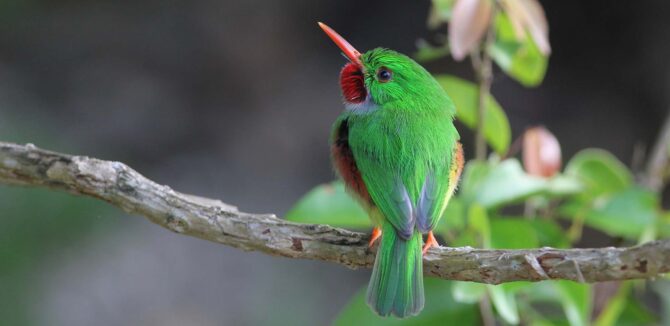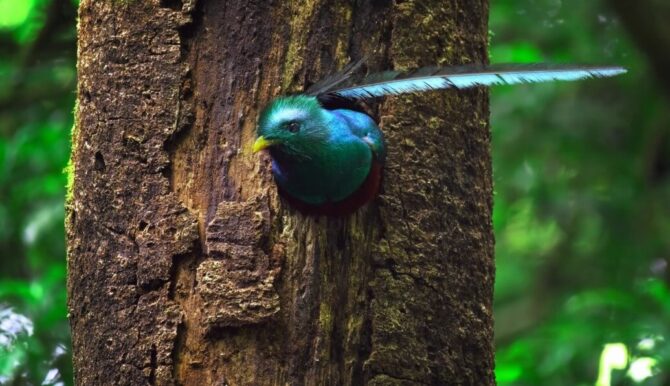The different types of red birds are some of the most stunning and awe-inspiring creatures in nature.
Their vibrant colors make them stand out from other species, adding a touch of magic to any landscape or garden.
From the Northern Cardinal to different tanagers and the scarlet macaw, these unique feathered friends bring something special to our skies.
Some may have red plumage in some parts of their body, like the breast or head.
To help you on your birdwatching adventures, our guide features 12 beautiful birds, along with pictures, their unique features, and characteristics, so that you never miss one again!
Beautiful Types of Red Birds
Fun Fact: Tropical birds are more colorful than their temperate counterparts. 1
1. Northern Cardinal
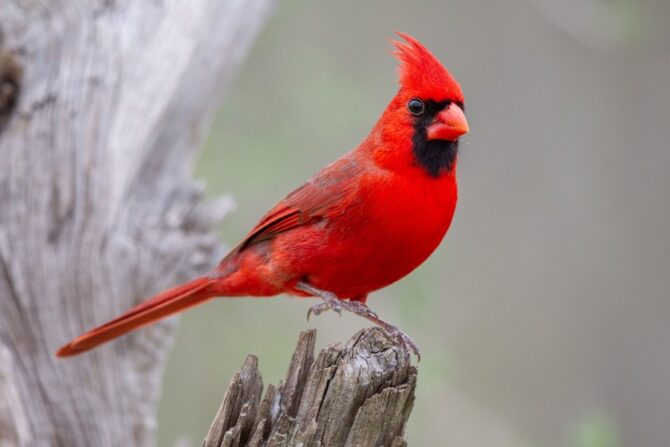
- Scientific Name: Cardinalis cardinalis
- Range: North America
The Northern Cardinal is a brightly colored bird native to North America.
It is known for its red plumage and crest on its head and can be found in various habitats, including woodlands, swamps, and suburban areas.
It is a year-round resident and does not migrate, and it is known for its loud, clear calls and songs, as well as its unique behavior of feeding in pairs.
It can be recognized by its bright red plumage, black mask-like facial markings, and crest on its head, and it is known to defend its territory fiercely.
Related: 30 Beautiful Birds With Mohawks
2. Scarlet Tanager
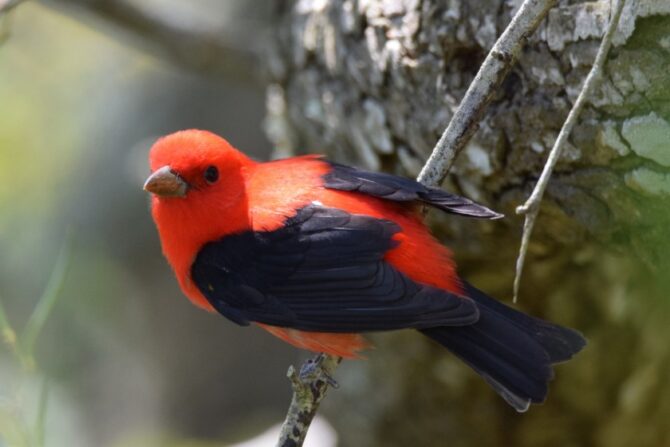
- Scientific Name: Piranga olivacea
- Range: North America
The scarlet tanager is native to North America, found throughout much of the eastern and central United States and parts of Canada and Mexico.
During the breeding season, males have striking scarlet plumage with black wings and tails, while females and non-breeding males are yellowish-green.
They can be found in wooded habitats such as deciduous and mixed forests, wooded swamps, riparian areas, orchards, and suburban areas.
They have a unique behavior of flying long distances to pursue flying insects, constituting a large part of their diet.
They have a distinctive song that is a clear, musical trill and a sharp, metallic “chip” call and are often found foraging in the canopy. They are a favorite among birders.
3. Summer Tanager

- Scientific Name: Piranga rubra
- Range: North America
The Summer Tanager is a songbird species found in the United States, Mexico, and Central America.
It is known for its bright red plumage and black wings, making it easy to identify in its natural habitat.
This bird has a wide range, including the eastern and central parts of the United States, Mexico, and Central America.
They can be found in various habitats, including woodlands, forests, and gardens. They are known to be particularly fond of oak trees and other hardwoods.
Uniquely, the Summer Tanager is one of the few birds that changes color from red to yellow during the winter.
The male Summer Tanager is entirely red, while the female is a duller yellow-green color.
This striking coloration makes the Summer Tanager easy to spot in its natural habitat. In addition, they are known for the loud and clear songs they sing during the breeding season.
Their calls are also quite distinctive, consisting of a sharp “chip” or “chick” sound.
These vocalizations are typically heard during the breeding season and are used by males to establish and defend their territory.
They are also known to be aggressive in their defense of their territory and nests, even attacking much larger birds such as crows.
Overall, the Summer Tanager is a beautiful and interesting bird worth observing in the wild.
4. Vermilion Flycatcher

- Scientific Name: Pyrocephalus rubinus
- Range: North and South America
The Vermilion Flycatcher is native to the Americas, known for its bright red head and breast plumage, which sets it apart from other birds in its range.
It can be found throughout much of the Americas, including parts of North, Central, and South America.
They are typically found in open woodlands, savannas, and other habitats with scattered trees and around human-made structures such as buildings, bridges, and power lines.
They are known for their aerial displays, aggressive territorial behavior, and loud and clear songs.
Their calls are composed of sharp, clear notes often described as “chek-chek-chek” or “chek-burr.”
They are heard during courtship displays, which include aerial acrobatics and diving at the female.
The females’ more subdued calls are used primarily to communicate with males during nesting.
5. Red-billed Firefinch
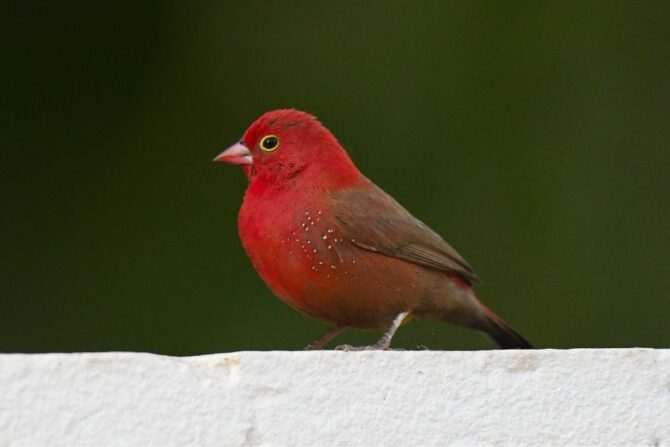
- Scientific Name: Lagonosticta senegala
- Range: Africa
The red-billed firefinch is a small bird species native to sub-Saharan Africa. They can be identified by their bright red bill and red rump, as well as the black band on their wings.
The males also have red heads and breasts, while the females are more subdued in color with gray-brown heads and breasts.
The red-billed firefinch has a wide range that stretches from Senegal in the west to Sudan in the east and from Ethiopia in the north to South Africa in the south.
The bird can be found in a variety of habitats, including savannas, grasslands, and scrublands.
One of the unique identifying characteristics of the red-billed firefinch is its bright red bill, which gives it its name.
The red-billed firefinch is known for its unique behavior of forming large flocks, often with other finch species.
The birds are also known for their melodious songs and calls, which they use to communicate with each other and attract a mate.
Their song is a sharp, high-pitched “tseet” or “chirrup” call, often heard in flocks.
They have a wide range of vocalizations and calls to communicate with their flock, and they can be used to signal alarm or to attract a mate.
6. Scarlet Ibis
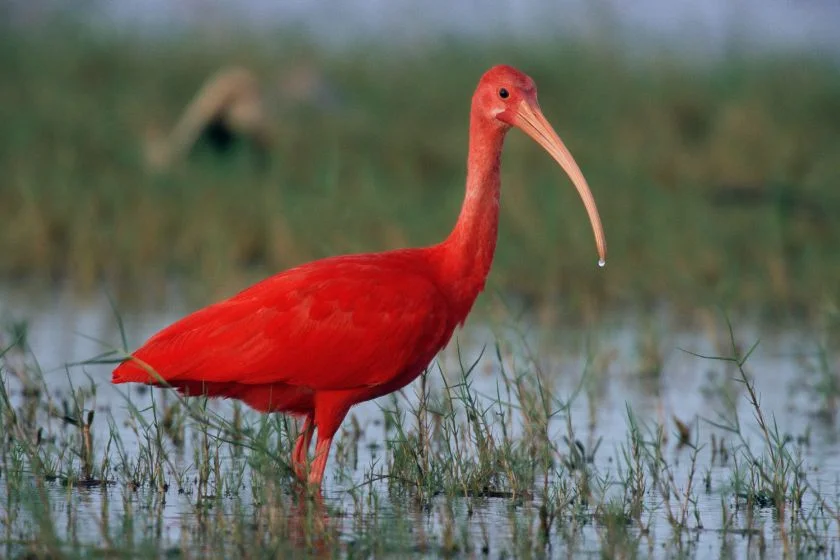
- Scientific Name: Eudocimus ruber
- Range: South America, Caribbean
The scarlet ibis is a national bird of Trinidad and Tobago and is quite popular in tropical South America.
Just as the name states, the scarlet ibis has colored a bright scarlet which makes it stand out amongst ibis species.
Its other name is guará. The scarlet ibis is protected throughout the world.
Its feathers are predominantly scarlet, and the only side of its body not colored scarlet is the wingtip which is a rich black.
Its bill is also long and black. The scarlet ibis tends to walk on foot or glide through the water, but it flies a lot too.
7. Scarlet Macaw
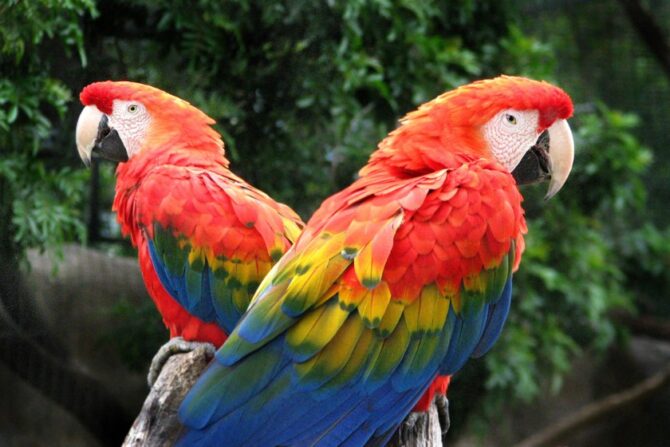
- Scientific Name: Ara Macao
- Range: Mexico, Peru, Bolivia, Brazil, Bolivia
The scarlet macaw is a parrot that can be found in Central and Southern America.
It is easily recognized by the color combination of red, yellow, and blue, and with a length of 32 inches, it is bigger than many other parrot species out there.
It also has broad wings. Amongst macaws, it is the most striking.
Just as its name implies, this bird’s plumage is mostly scarlet, but the wing feathers feature different colors like red, yellow, blue, and even green on some individuals.
The tail is long, making up about half of the total length. Altogether, the scarlet macaw is like a flying rainbow.
These birds are also easy to find in their various habitats. They make different vocal sounds like a squawk, a scream, or a squeak.
Their preferred habitats include woodlands, subtropical rainforests, and savannahs.
8. Red-headed Woodpecker

- Scientific Name: Melanerpes erythrocephalus
- Range: North America
The red-headed woodpecker is a medium-sized woodpecker native to North America and known for its striking plumage, which includes a bright red head and neck, black and white barred wings and tail, and a white belly.
Its range extends from southern Canada to northern Mexico, and it can be found in a variety of habitats, including deciduous and mixed woodlands, orchards, and wooded wetlands.
One unique behavior of the red-headed woodpecker is its acrobatic foraging, often hanging upside down to search for food.
They eat a variety of insects, fruits, and seeds. Their calls are loud and sharp, described as “kent” or “churr” sound, and their drumming is faster than other woodpeckers.
They also have a loud, clear, and far-carrying song, which is often heard in spring and early summer.
They also have a unique behavior of drumming on metal objects, such as metal roofing, utility poles, and even car bodies. This behavior is thought to be used to establish territory and attract a mate.
9. Red-capped Cardinal
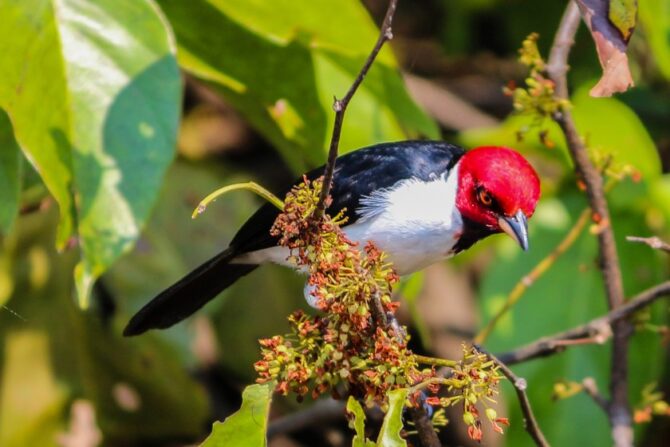
- Scientific Name: Paroaria gularis
- Range: South America
The Red-capped Cardinal is a brightly colored species native to South America.
It can be found in a wide range of habitats, including forests, savannas, and grasslands, and is particularly common in the Pantanal region of Brazil, Paraguay, and Bolivia.
One of the most unique identifying characteristics of the Red-capped Cardinal is its bright red head and crest, which stands out in contrast to its primarily gray body.
They have a black mask around their eyes. They also have a distinctive white patch on the wings and tail.
They are medium-sized birds, measuring about 8 inches in length and weighing around 1.5 ounces.
In terms of behavior, the Red-capped Cardinal is a non-migratory bird known for its loud, melodic songs and calls. They are social birds and are often seen in flocks.
They are also known to be quite aggressive when defending their territory and often engage in loud, aggressive vocalizations and physical displays to ward off potential rivals.
They are also known to be quite acrobatic, often seen flying in tight circles and performing aerial displays.
10. Red-crested Cardinal
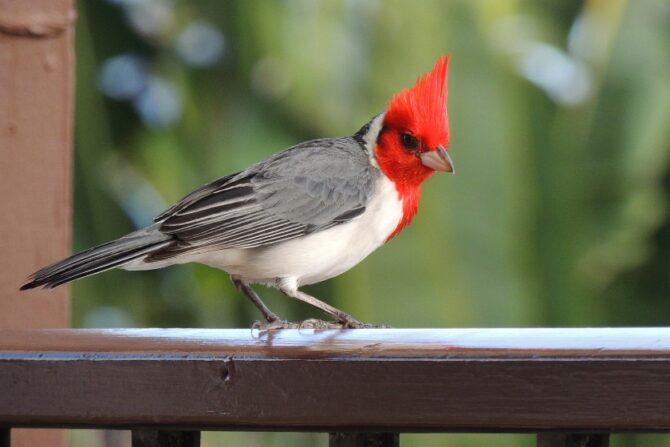
- Scientific Name: Paroaria coronata
- Range: South America
The red-crested cardinal is a tropical bird found primarily in South America, particularly in Brazil, Paraguay, and Argentina, but also in other countries such as Uruguay, Bolivia, and Peru.
It is known for its bright red plumage on the head, crest, and breast, as well as a black mask around the eyes. These birds have a large, conical bill that is black.
They are known for their loud, melodic songs, which are heard in the early morning and late afternoon and are also known for their aggressive behavior towards other birds during the breeding season.
They form long-term pair bonds, fluff up their feathers when defending their territory, and typically inhabit open woodlands, savannas, and wetlands, as well as urban and suburban areas, often seen in flocks.
They are a popular target for birdwatchers and photographers due to their bright red plumage and calls.
11. Red-winged Blackbird

- Scientific Name: Agelaius phoeniceus
- Range: North and South America
The Red-winged Blackbird is a common species of blackbird native to North America. The range of this species extends from southern Canada to northern Mexico and Central America.
The male red-winged blackbird is easily recognized by its glossy black plumage and distinctive red and yellow shoulder patches, or “epaulets.” The female is less colorful, with a streaked brown plumage.
Red-winged blackbirds are found in a wide variety of wetland and grassland habitats, including marshes, swamps, fields, and prairies.
They are particularly common in agricultural areas, such as corn and rice fields. They are also known to nest in trees and shrubs and will use man-made structures such as utility poles for nesting.
Red-winged blackbirds are known for their distinctive songs and calls. Male red-winged blackbirds have a loud and complex song, often described as “konk-la-ree,” which they use to establish and defend their territory.
The males also have a variety of calls, including a sharp “chek” call, which they use to communicate with other males, and a softer “whistle” call, which they use to communicate with females.
12. Western Tanager

- Scientific Name: Piranga ludoviciana
- Range: North America
The Western Tanager is found in western North America, primarily in coniferous forests.
They can be identified by their brightly colored plumage, with males having a red head, yellow body, and black wings and tail, and females being yellow-green with yellow head and black wings and tail, a distinctive large, conical bill, and a long tail.
They are typically found in coniferous forests, woodlands, gardens, and orchards.
They are migratory birds, spending summers in western North America and winters in Mexico and Central America, and are known for catching insects in mid-flight.
They have a wide variety of songs and calls, often described as sharp, clear, and ringing, complex and melodic, and a harsh “chip” or “chick” sound.
Wrap Up
In conclusion, there are many different types of red birds that can be found all over the world.
From the vibrant scarlet tanager to the striking red cardinal, these birds come in a variety of shapes and sizes.
Each species has its unique characteristics and habitats, making them a fascinating subject for birdwatchers and nature enthusiasts alike.
With the help of this article and the accompanying pictures, you can now easily identify and appreciate the beauty of these red bird species.
Up Next…
References & Notes
- Cooney, C. R., He, Y., et al. (2022). Latitudinal gradients in avian colourfulness. Nature Ecology & Evolution, 6(5), 622-629.
